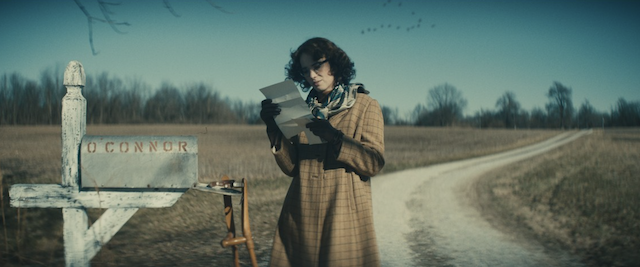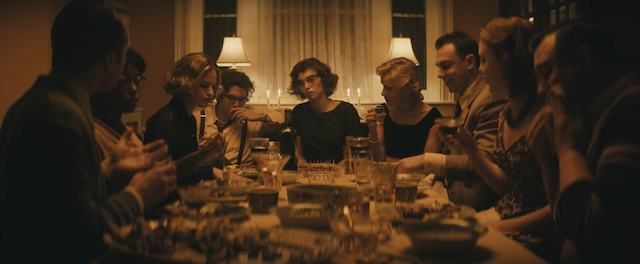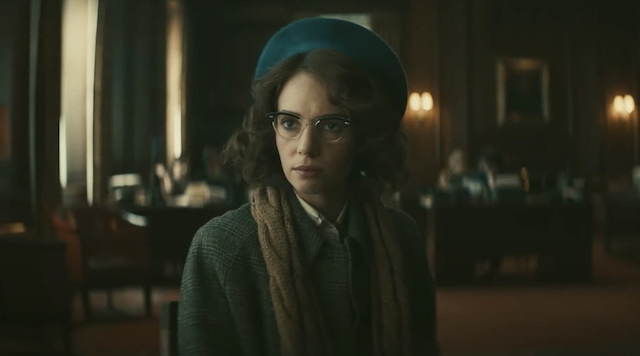
©Courtesy of Oscilloscope
The best compliment I can give to the heartbreaking biopic directed by Ethan Hawke is that five seconds after the ending titles started I was already researching the short stories and novels published by Flannery O’Connor (1925-1964). From the Queens Public Library, I borrowed her first book Wise Blood by the way.
Wildcat doesn’t follow the usual storytelling of movies talking about artists or elected minds, where showing their private lives and their stories means in some way understanding their work in a better, deeper way. What Hawke delivers from the very beginning is instead a cinematic universe where the writer and the characters who live in her mind are the same thing, meaning the product of a specific environment and an even more specific existence.
Flannery O’Connor wrote about the world she grew up in and knew better, depicting it without the glittering lens that most of the time fiction provides: on the contrary, the skepticism, the sarcasm, and the pain of her own existence turned her stories into something so true and at the same time so private, that it would be extremely difficult for them to be understood, let alone appreciated, by the common reader.
She dared to expose her view of the world – her world – through the pain she was experiencing. By doing this, Flannery O’Connor addressed difficult topics like religion, racism, illness, and many others with the depth and the truth that this movie remarkably achieves. Behind the surface of the so-called “Southern Gothic” style the reader – and thanks to Wildcat the viewer – can feel the novelist’s touch implanting under the skin.

©Courtesy of Oscilloscope
As a director, Ethan Hawke is capable of inserting all of this in elegant and symmetric images, which convey that sense of silent desperation that Flannery O’Connor put in her works. The cinematographer Steve Cosens does a remarkable job of showing the melancholy and aridity of the southern countryside, loading many scenes through a light that often weighs with violence and brutality upon human beings, objects, and nature. But Hawke’s best achievement is how he directs his daughter Maya, capable of portraying a woman who rebels against the hypocrisy of her world exactly because she doesn’t want to be a rebel.
Her Flannery O’Connor wants to be understood and wants the readers to feel the pain and desperation she is experiencing, not only about her condition (after battling for years with Lupus she died at the age of 39) but also about living in a society still plagued with injustice and prejudices. The way Maya Hawke uses the gentleness of her appearance, and the softness of her voice, makes the character even more heartbreaking.
A supporting cast that includes the always precious Laura Linney, together with Cooper Hoffman, Vincent D’Onofrio, Steve Zahn, and Liam Neeson among others, elevates the acting contained in Wildcat to something profoundly touching. For example, the simple, intimate scene in which Flannery confesses her fears and doubts to the priest is incredibly moving, mostly thanks to performances by Hawke and Neeson.
Eight years ago Ethan Hawke gave one of the best performances of his stunning career in Maudie by Aisling Walsh, based on the real life of painter Maud Lewis. There is something of that gentle and touching movie in Wildcat, an approach to the character that Hawke turns into a sort of hypnotic limbo, adapting his movie’s aesthetic to the unsettling universe of Flannery O’Connor’s stories. The inner coherence between what the audience sees and what the main character goes through in the movie is remarkable, a demonstration that Hawke fully understood Flannery O’Connor. It doesn’t happen that often when it’s about biopics. At least not at this level.

©Courtesy of Oscilloscope
RATE: B+
If you liked the article, share your thoughts below!
Check out more of Adriano’s articles.
Here’s the trailer of the film.

